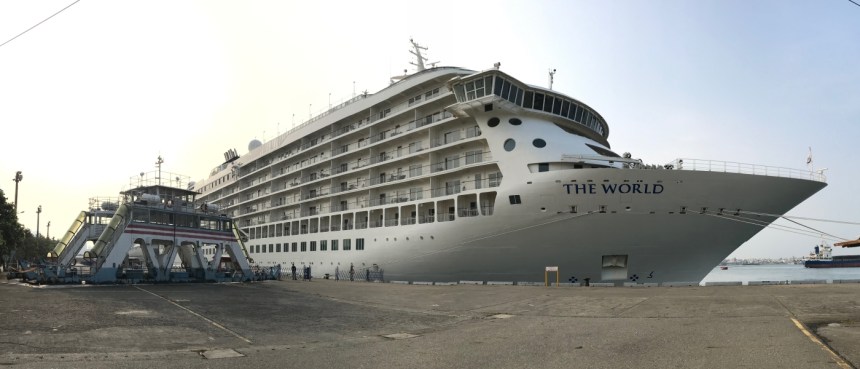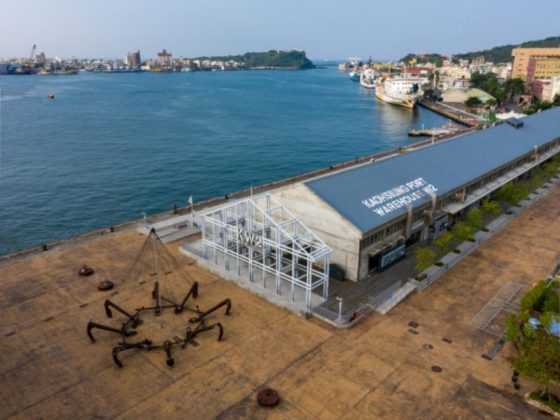Kaohsiung, situated on the southwest coast, is Taiwan’s largest southernmost city. Dating back to the 17th Century, Kaohsiung is known for its shipbuilding and freighting industries, as well as its many night markets, and museums. One of the best parts of your cruise Kaohsiung Taiwan experience is getting to see the best of what this wonderful city has to offer – cruises shouldn’t just be spent onboard the ship, you know? Here is part one of your cruise tour in Kaohsiung – two great places you can visit during your time in the city. (Read more: Visiting Kaohsiung, Southern Taiwan’s Largest City)

Fo Guang Shan Buddha Museum (佛光山佛陀紀念館)
Fo Guang Shan Monastery in Kaohsiung’s Dashu district (大樹區) is where you’ll find the very impressive Fo Guang Shan Buddha Museum. Home to the iconic golden Big Buddha statue, which sits proudly on the roof of the Fo Guang Building to the museum’s rear, Fo Guang Shan is a must-visit for tourists in Kaohsiung. The museum itself houses several dedicated exhibitions, such as a gallery of Buddhist festivals and 48 underground palaces preserving a vast collection of artifacts, including one of the tooth relics of Sakyamuni Buddha, the founder of the Buddhist faith. The Fo Guang Big Buddha, made of 1,800 tons of metal, is 40 meters high and, when combined with its seat and the building it sits on, reaches a height of 108 meters – 108 being an auspicious number in Buddhism.
Outside of the museum, leading up to Bodhi Wisdom Concourse is the Great Path to Buddhahood – a long stretch of path perfect for photographs, flanked by eight towering pagodas each representing a different idea or percept: One Teaching Pagoda, Two Assemblies Pagoda, Three Goodness Pagoda, Four Givings Pagoda, Five Harmonies Pagoda, Six Perfections Pagoda, Seven Admonishments Pagoda and Eightfold Path Pagoda. The Bodhi Wisdom Concourse is where you’ll find the Eighteen Arhats, statues designed by Taiwanese sculpture Wu Jung Tzu depicting the Ten Great Disciples of the Buddha, three Arhats from Amitahba Sutra, two from Chinese folklore and three female bhiksunis.

Part of your visit to the museum will include a calligraphy experience, where you’ll get the chance to try your hand at writing Chinese characters. There is also a one-stroke calligraphy exhibit displaying the works of Venerable Master Hsing Yun and information on his Public Education Trust Fund. Do you think you have what it takes to write beautiful Chinese characters? As well as calligraphy, the museum boasts many types of art work, including art galleries on the first and second floors of the Main Hall. (You might also like: 5 things to do in Kaohsiung)

Tianliao Moon World (田寮月世界)
Boasting Taiwan’s largest concentration of mud volcanos and badlands, Tianliao is a great spot to take in a prime example of the natural beauty and landscapes that the island is so famous for. Referred to by many as Taiwan’s “Moon World”, Tianliao’s naturally-formed terrain is a geological phenomenon. The area is characterized by rolling hills, valleys and a rain-eroded karst landscape and gets its name due to its resemblance of the surface of the moon. Moon World’s formation came about as a result of crustal rejuvenation, a process that saw rain water and the river deposit sand onto mudstone. Over time, a combination of weathering and the environment transformed the sand and mudstone into the fascinating moon-like landscape we see today.

The Lakeside Trail in Moon World connects many of the various geographical formations across Tianliao district. Starting by the Riyue Zen Buddhist Temple, it connects sites such as Jade Pond, Moon Pond, and the “Ladder to Heaven” and will have you feeling like you’re walking on the moon – except in full gravity, of course. You’ve also got to find the time to visit Wulikeng (五里坑), a peaceful area filled with dams acting as aquafarms, while the coral trail behind Chaoyuan Temple(朝元寺), lined with naturally-occurring karst formations, such as the stalactites at Yi-xian-tian, is another must-see.
Chaoyuan Temple itself is also an impressive structure. More than 300 years old, it houses an impressive clay statue of Master Zhijing (智淨法師) which has a beard that goes down past its knees and is supposedly still growing.

You’ve also got to check out the mud volcanoes. They are essentially faux-volcanoes that are formed when natural gas and mud erupt out of shallow underground rock fissures under high pressure. The mud volcanoes in Tianliao are active and the mudflow that they deposit is eroded by rainfall and result in some of the geographical formations found in the area. Two of the best examples of mud volcanoes are Lesser Gunshui (小滾水) and Larger Gunshui (大滾水) in Chongde (崇德里) and Guting villages (古亭村) respectively. Lesser Gunshui in particular is worth visiting as it is surrounded by bubbling mud craters and a varying water level that acts as a gauge of the levels of natural gas under the earth’s surface.
Also, be sure to try the local food, especially Chongde Village’s free-range chicken wrapped in volcanic mud that is served incased in mud and then cracked on the table in front of you prior to eating.

If you’re interested in touring these wonderful parts of Kaohsiung as part of your cruise Kaohsiung Taiwan experience, customize one here NOW!
Can’t Get Enough of Kaohsiung?
Looking for more options for your cruising experience? Here’re the part 2 and part 3 of Cruise Kaohsiung Taiwan!












Comments are closed.